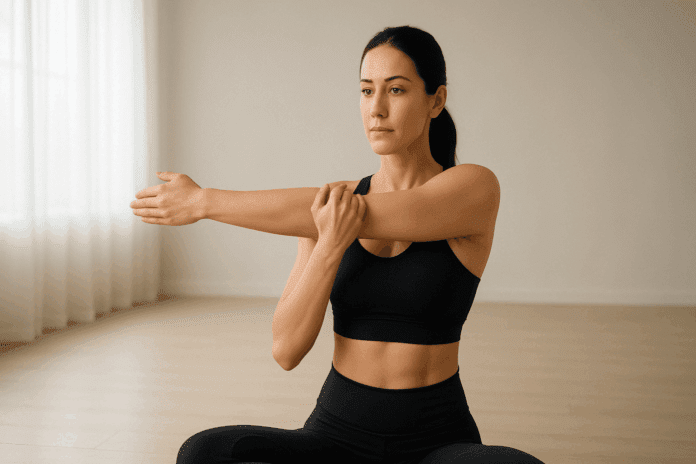Improving shoulder flexibility and mobility is essential not only for athletes and fitness enthusiasts but for anyone who spends long hours at a desk, drives frequently, or engages in repetitive upper body movements. The shoulder joint is one of the most mobile yet vulnerable joints in the human body, making it susceptible to stiffness, discomfort, and injury if not properly maintained. Two of the most accessible and effective exercises for shoulder health are the crossed arm stretch and the arm across chest stretch. These movements may seem deceptively simple, but when performed with proper technique and intention, they can offer substantial benefits for joint range of motion, muscular flexibility, and overall upper body posture. This article explores in detail how to do the crossed arm stretch and arm across chest stretch safely and effectively, drawing from expert recommendations to enhance their benefits while minimizing the risk of injury.
You may also like : Best Stretches for Sore Legs and Tight Thigh Muscles: How to Relieve Upper Leg Pain Safely and Naturally
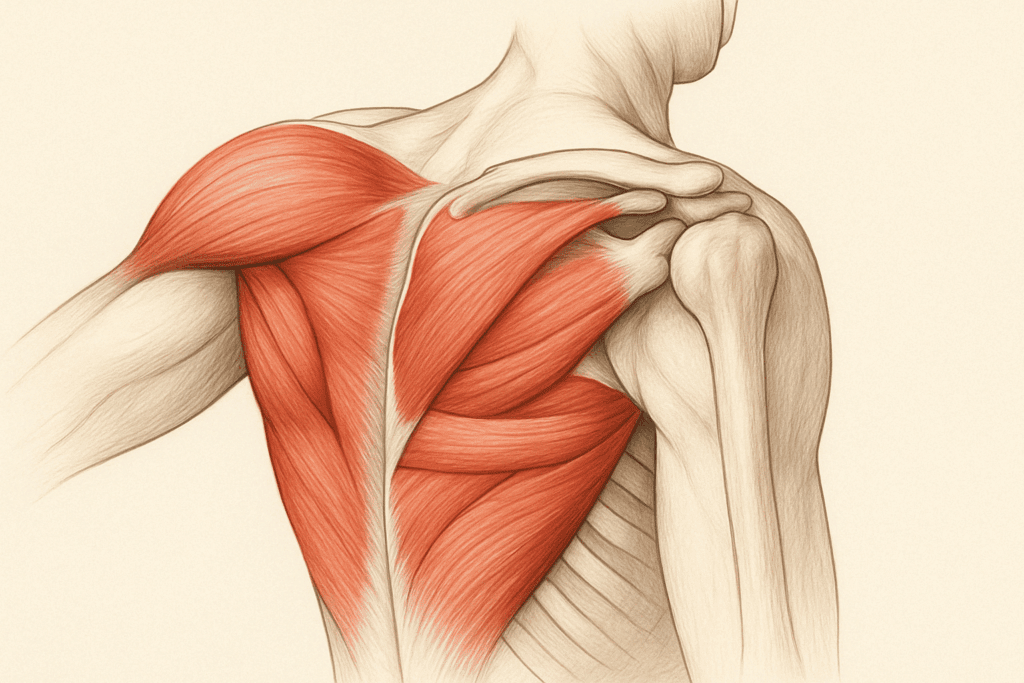
Understanding the Importance of Shoulder Flexibility
Before diving into technique, it’s vital to understand why shoulder flexibility matters. The shoulder complex consists of multiple joints and a vast network of muscles, tendons, and ligaments that facilitate a wide range of movement. Because of this complexity, shoulder stiffness or weakness in just one part of the joint structure can lead to compensatory movement patterns, which in turn may contribute to neck pain, back strain, or even injuries to the rotator cuff. Enhancing flexibility in the shoulder region helps ensure that all surrounding tissues can move freely and function in harmony.
Shoulder stretches like the crossed arm stretch and arm across chest stretch are particularly effective because they target the posterior deltoid and surrounding muscles. These muscles often become tight from activities like typing, driving, or lifting, which involve the arms being in front of the body for extended periods. Regular stretching of this area supports postural alignment, aids in recovery from exercise, and helps prevent overuse injuries that may otherwise result from a restricted range of motion.
The Science Behind Stretching and Shoulder Mobility
Stretching increases muscle length and elasticity, which promotes a greater range of motion around the joint. Scientifically, stretching influences the viscoelastic properties of the muscle-tendon unit. When a muscle is held in a lengthened position, the muscle fibers and connective tissues gradually adapt to this new length, especially when stretching is practiced regularly over time. Furthermore, stretching stimulates proprioceptive sensors in the joints and muscles, enhancing body awareness and coordination.
In the context of the shoulder joint, which relies on a delicate balance of mobility and stability, regular stretching plays a crucial role in injury prevention. For example, if the posterior shoulder capsule becomes tight, it can limit internal rotation and lead to impingement syndromes or labral tears. Stretches like the arm across chest stretch and the crossed arm stretch help keep these structures supple, especially when integrated into a broader program that includes strengthening and movement control exercises.
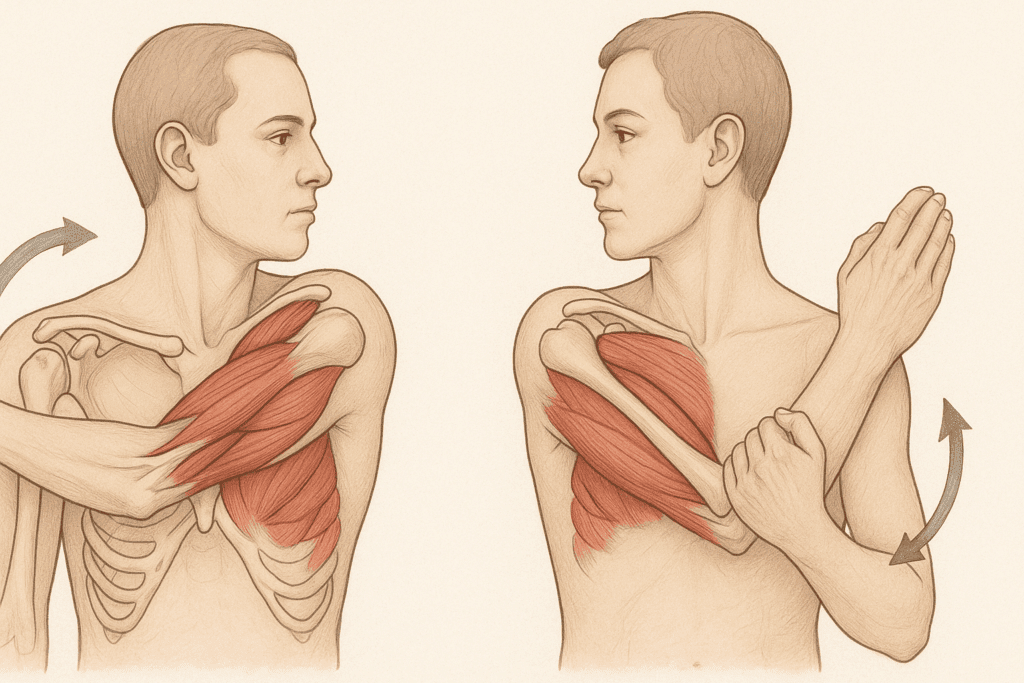
Functional Anatomy and Biomechanics of Shoulder Flexibility
Understanding the muscles and joints involved in the crossed arm stretch and arm across chest stretch offers deeper appreciation for their impact. The shoulder is a ball-and-socket joint comprising the humerus (upper arm bone), scapula (shoulder blade), and clavicle (collarbone). The rotator cuff, deltoids, trapezius, rhomboids, and latissimus dorsi all coordinate to allow multidirectional movement. These stretches primarily affect the posterior deltoid, teres minor, and infraspinatus, but they also influence the joint capsule and scapulothoracic articulation.
The crossed arm stretch emphasizes horizontal adduction and external rotation of the humerus. It places tension on the posterior shoulder capsule and activates proprioceptors, which play a crucial role in shoulder stability. Meanwhile, the arm across chest stretch, although similar in appearance, is more involved in scapular retraction and thoracic rotation when performed with controlled spinal posture. This subtle difference makes it particularly beneficial for restoring functional range in throwing athletes and individuals recovering from frozen shoulder.
Stretching and Fascia: A Myofascial Perspective
Another often-overlooked dimension of stretching is its effect on fascia—the connective tissue that envelops muscles, nerves, and organs. Chronic tightness in the upper back and posterior shoulder can result not just from muscle shortness but also from fascial adhesions. Gentle, sustained stretches like the arm across chest stretch can stimulate myofascial release, particularly when held for 60 seconds or longer and integrated with diaphragmatic breathing.
Fascial manipulation specialists and somatic movement therapists often recommend combining these stretches with soft tissue techniques, such as foam rolling or trigger point therapy, to maximize mobility gains. Additionally, hydration and nutritional support for collagen synthesis—such as adequate intake of vitamin C, protein, and omega-3 fatty acids—can complement the structural adaptations induced by stretching.
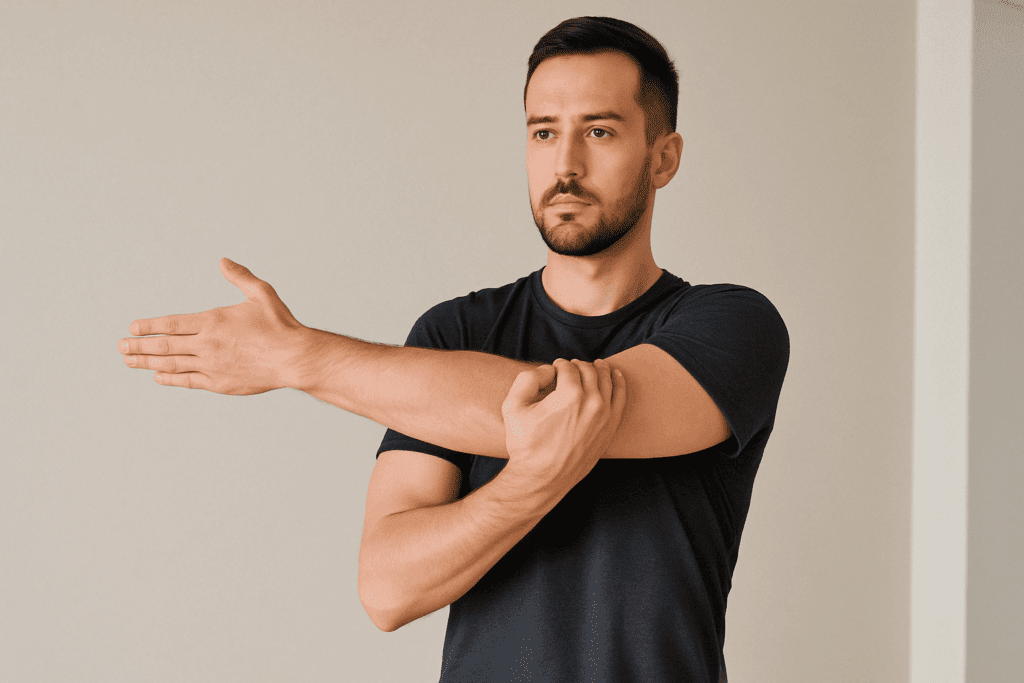
How to Perform the Crossed Arm Stretch Safely and Effectively
The crossed arm stretch, also known as the horizontal shoulder stretch, is a staple in many fitness routines and physical therapy programs. Despite its simplicity, improper form can reduce its effectiveness or even lead to strain. To begin the crossed arm stretch, stand or sit upright with the spine elongated and the shoulders relaxed. Bring one arm across the front of your body at shoulder height, aiming to keep the arm parallel to the ground.
With the opposite hand, gently grasp the forearm or upper arm and pull it closer to the chest, ensuring the shoulder remains down and not shrugged up toward the ear. It’s crucial to avoid twisting the torso or bending at the waist during this movement, as doing so can transfer the stretch away from the target muscle. Instead, keep the torso square and breathe deeply to encourage relaxation of the muscles.
Hold the stretch for 20 to 30 seconds, focusing on a mild to moderate stretch sensation in the back of the shoulder. Never force the stretch to the point of pain, as this can lead to micro-tears or irritation in the soft tissues. Repeat on the opposite side. Experts recommend performing the crossed arm stretch two to three times per arm, especially after strength training or long durations of sitting.
Integrating These Stretches into Functional Movement Training
Athletic training programs increasingly emphasize functional movement, which means training muscles in coordinated patterns that reflect real-life activities. Both the arm across chest stretch and the crossed arm stretch can be used as preparation for exercises involving pushing, pulling, or overhead movements. For example, stretching the posterior shoulder before performing barbell overhead presses or snatches can enhance scapular rhythm and reduce risk of impingement.
In functional training environments, dynamic versions of these stretches can be introduced during warm-ups. Swinging one arm gently across the chest while walking, or incorporating arm swings into a yoga flow or Pilates sequence, allows for dynamic lengthening of the shoulder musculature while maintaining full-body integration. This prepares the nervous system and joints for activity and helps transfer flexibility gains into active mobility.

Clinical and Rehabilitation Contexts: From Injury Recovery to Postural Correction
In clinical rehabilitation, the crossed arm stretch is frequently used to manage conditions such as adhesive capsulitis, rotator cuff tendinopathy, and posterior capsule tightness. Physical therapists often assess the quality and symmetry of this movement during a physical exam. For patients with impingement syndromes or throwing injuries, limited internal rotation of the shoulder is a key concern that can be mitigated through posterior capsule mobilization.
The arm across chest stretch, particularly when performed with thoracic extension and spinal awareness, can help correct rounded shoulders and upper cross syndrome—a postural imbalance common among desk workers and students. In this context, these stretches contribute to restoring scapular positioning and reducing anterior chain dominance.
Case studies and randomized trials have shown that including gentle posterior shoulder stretches in physical therapy programs improves range of motion, decreases pain, and facilitates return to sport or daily activity. However, stretching alone is rarely curative; it must be part of a multimodal approach that includes joint mobilization, strengthening, and movement re-education.

Crossed Arm Stretch and Arm Across Chest Stretch in Aging Populations
Shoulder mobility declines with age due to a combination of sarcopenia (muscle loss), connective tissue stiffness, and reduced physical activity. The crossed arm stretch and arm across chest stretch can be instrumental in preserving joint integrity and functional independence in older adults. When done regularly and gently, these movements promote circulation to the shoulder girdle, reduce stiffness, and support continued ability to reach, carry, and perform self-care tasks.
In geriatric exercise programs, these stretches are often paired with scapular strengthening exercises to maintain balance between mobility and stability. For example, combining the arm across chest stretch with banded scapular retractions or wall slides can help older adults maintain posture and prevent falls. These protocols emphasize low load, high awareness movement patterns with an emphasis on breath and body awareness.
Mastering the Arm Across Chest Stretch for Maximum Benefit
The arm across chest stretch is often used interchangeably with the crossed arm stretch, but subtle differences in execution and intention can yield different results. This stretch primarily targets the posterior deltoid, rhomboids, and trapezius muscles. To perform this stretch, begin by standing or sitting tall. Extend one arm straight across your body at chest level. Using your opposite hand, press the arm toward your chest, ideally just above or below the elbow joint to avoid placing pressure directly on it.
As you press the arm inward, maintain a neutral spine and avoid letting the shoulder rise or rotate forward. A common mistake during the arm across chest stretch is allowing the shoulder blade to wing out or the stretching arm to drop, which diminishes the stretch’s effectiveness. Keeping the arm at chest height and the scapula stable ensures that the targeted muscles are appropriately lengthened.
Like with the crossed arm stretch, hold the stretch for 20 to 30 seconds, breathing calmly to deepen the stretch as the muscles relax. Repeat on both sides, and incorporate this stretch as part of a dynamic warm-up or cool-down routine. Physical therapists often include this stretch in shoulder rehabilitation programs because of its capacity to gently restore motion and reduce muscular tightness.
Common Mistakes to Avoid When Stretching the Shoulders
Both the crossed arm stretch and arm across chest stretch are simple but not immune to error. One of the most frequent mistakes is shrugging the shoulder being stretched, which not only decreases the stretch’s effectiveness but also places strain on the neck muscles. It’s important to keep the shoulders relaxed and down, maintaining proper alignment of the cervical spine throughout the stretch.
Another common error is rotating or tilting the torso to assist the stretch. This compensatory movement may feel like a deeper stretch but actually shifts the work away from the targeted musculature. Instead, focus on isolating the shoulder muscles by stabilizing the core and maintaining upright posture. Additionally, applying excessive force during the stretch can result in injury, especially in individuals with pre-existing shoulder conditions.
To avoid these pitfalls, always perform shoulder stretches in front of a mirror when possible or under the supervision of a qualified professional. Pay close attention to your body’s feedback and progress gradually. Remember that flexibility gains are best achieved through consistency and proper form, not intensity or force.
The Role of Breathing and Mindfulness in Stretching
Breathing deeply and mindfully while stretching can significantly enhance the benefits of movements like the arm across chest stretch and crossed arm stretch. Controlled breathing helps activate the parasympathetic nervous system, promoting relaxation and reducing muscle tension. When combined with intentional stretching, this approach allows muscles to lengthen more effectively and can also enhance the mind-body connection.
Inhale deeply through the nose before initiating the stretch, and exhale slowly as you deepen into it. This rhythmic breathing encourages your body to release tension and creates a sense of ease that supports muscle elongation. Mindfulness during stretching also helps prevent injury by fostering body awareness. By staying present and attuned to physical sensations, you’re more likely to detect discomfort or improper form early and adjust accordingly.
Practicing mindfulness during stretches can also serve as a form of active recovery, particularly after strenuous workouts or prolonged sedentary activity. Stretching sessions that incorporate deep breathing and mindful attention can become meditative, reducing stress levels and promoting overall well-being.
When and How Often to Stretch for Optimal Results
Incorporating the crossed arm stretch and arm across chest stretch into your routine requires thoughtful timing and consistency. These stretches are most effective when performed as part of a comprehensive mobility program that includes both static and dynamic movements. Static stretches like these are ideally performed after exercise, when the muscles are warm and more pliable. However, they can also be used as gentle movement breaks throughout the day, particularly for individuals with sedentary lifestyles.
For long-term improvements in flexibility and shoulder function, experts recommend stretching each shoulder muscle group at least three to five times per week. This frequency supports gradual improvements in range of motion while also promoting tissue recovery. It’s important to balance stretching with strengthening exercises to maintain shoulder joint stability, as overly flexible joints without adequate muscular support may become unstable.
Consistency is more important than duration. A few minutes of focused, well-executed stretching each day can yield better results than longer, sporadic sessions. Over time, regular practice of the arm across chest stretch and crossed arm stretch can contribute to better posture, reduced muscle tension, and greater ease of movement in everyday activities.
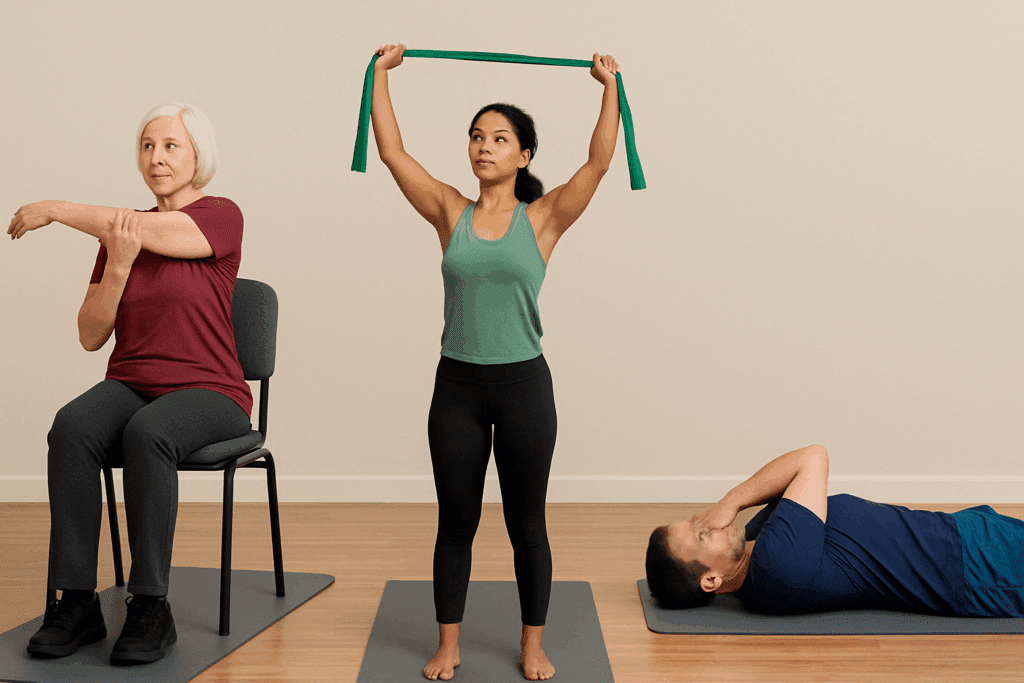
Modifications and Variations for Different Fitness Levels
Both the arm across chest stretch and crossed arm stretch can be adapted to suit various fitness levels and physical limitations. For individuals with limited shoulder mobility or previous injuries, performing these stretches while lying on the floor or seated against a wall can provide additional support and help maintain proper alignment. This setup prevents compensatory movements and ensures a safer, more effective stretch.
Athletes and individuals with advanced flexibility may benefit from adding gentle resistance to the stretch using a resistance band or partner assistance. For example, a light resistance band can be looped around the arm being stretched to increase the intensity slightly, provided it does not cause pain or discomfort. As always, any modification should be approached cautiously and tailored to individual needs.
Individuals recovering from surgery or managing chronic pain should consult with a healthcare provider or physical therapist before attempting shoulder stretches. In these cases, professional guidance can ensure that stretches are appropriately modified and integrated into a broader rehabilitation plan.
Integrating Shoulder Stretches into Your Daily Routine
Creating a daily movement habit that includes the arm across chest stretch and crossed arm stretch doesn’t require a significant time investment. These stretches can be easily incorporated into existing routines, such as morning mobility flows, post-workout cooldowns, or even mid-day breaks at the office. Performing these stretches while standing or sitting at a desk provides a practical solution for combating the effects of prolonged sitting and shoulder hunching.
To maintain consistency, link your stretching routine to an existing habit, such as brushing your teeth, finishing a workout, or winding down before bed. This approach, known as habit stacking, makes it easier to remember and sustain new health behaviors. Over time, stretching can become a seamless and rewarding part of your self-care regimen.
As your body adapts to regular stretching, you may begin to notice not only improved mobility but also greater awareness of posture and muscular balance. This heightened awareness can translate into improved performance in physical activities and reduced risk of overuse injuries, especially in sports that demand shoulder stability and motion, such as swimming, tennis, and weightlifting.
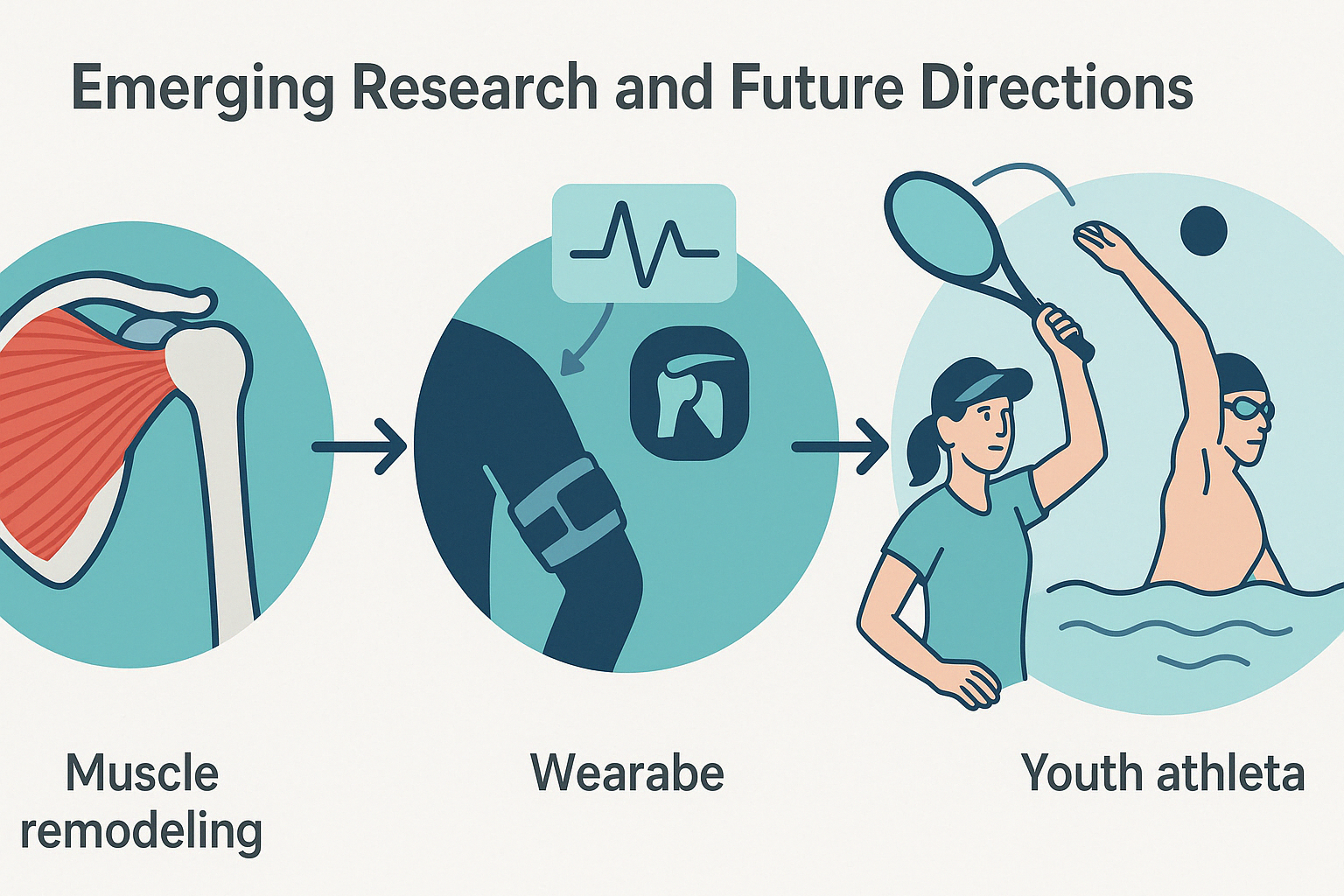
Emerging Research and Future Directions
Current research continues to explore the relationship between passive stretching and long-term changes in tissue architecture. Some studies suggest that prolonged, low-intensity stretching may stimulate collagen remodeling, while others focus on its role in downregulating inflammatory markers associated with chronic musculoskeletal pain.
There is also growing interest in how these stretches can affect thoracic outlet syndrome and postural dysfunction in youth athletes, especially those in overhead sports like baseball and volleyball. Investigations are underway into whether the crossed arm stretch can improve glenohumeral internal rotation deficit (GIRD), a common asymmetry in dominant arms of throwing athletes.
Furthermore, interdisciplinary programs are examining the effects of combined mobility and mindfulness training—such as yoga-based stretching with breathwork—on overall well-being and movement efficiency. As these fields converge, it is likely that the role of the arm across chest stretch and crossed arm stretch will expand beyond isolated flexibility work into integrated health optimization strategies.
Frequently Asked Questions: Crossed Arm Stretch and Arm Across Chest Stretch
1. Can these stretches help improve performance in sports like swimming or tennis?
Absolutely. The crossed arm stretch and arm across chest stretch are excellent for sports that involve repetitive shoulder use, such as swimming, tennis, and baseball. By regularly performing these stretches, athletes can improve the elasticity of the posterior shoulder capsule and enhance joint rotation, which is critical for executing overhead movements efficiently. For swimmers, maintaining optimal range of motion in the shoulder helps reduce drag in the water, while in tennis, better shoulder flexibility allows for a more powerful and controlled serve. These stretches also play a role in injury prevention by decreasing the risk of impingement and rotator cuff strain—common issues in athletes who rely heavily on shoulder mobility.
2. How do these stretches influence posture over time?
The arm across chest stretch and crossed arm stretch can contribute significantly to postural correction, especially in individuals with forward-rounded shoulders or kyphotic thoracic alignment. Over time, consistent stretching of the posterior deltoids and upper back can rebalance the muscle tension between the front and back of the shoulder girdle. This not only helps open up the chest but also improves the alignment of the scapulae, encouraging a more upright posture. When combined with strengthening exercises for the rhomboids and lower trapezius, these stretches become powerful tools for restoring muscular symmetry and postural integrity. Poor posture doesn’t develop overnight, and neither does the correction—but these stretches provide a reliable foundation for long-term improvement.
3. What are some advanced techniques to deepen these stretches safely?
To enhance the benefits of the crossed arm stretch, consider using proprioceptive neuromuscular facilitation (PNF), where you gently contract the stretched arm against resistance for a few seconds before relaxing deeper into the stretch. Another advanced technique is to perform the arm across chest stretch lying on a foam roller placed along the spine. This setup not only supports spinal alignment but also allows for greater scapular retraction, deepening the stretch while promoting thoracic extension. You can also introduce slow rotational movements of the cervical spine while holding the stretch to engage fascial lines that connect the shoulder to the neck. These progressions are particularly useful for athletes and dancers who require superior mobility and control.
4. Are these stretches useful during rehabilitation after surgery or injury?
Yes, when prescribed appropriately by a medical professional. The arm across chest stretch and crossed arm stretch are often introduced in the mid-to-late stages of physical therapy for shoulder surgeries such as rotator cuff repair or labral reconstruction. Their primary function in this context is to restore joint mobility and reduce post-surgical adhesions without overloading the healing tissue. However, the intensity and range of motion must be closely monitored, and patients are typically instructed to perform these movements in a supported or supine position to minimize compensatory movement. Adapting these stretches for the rehabilitative phase demonstrates their versatility across different recovery timelines.
5. How can these stretches be adapted for people with hypermobility or joint instability?
Individuals with hypermobility disorders must approach the crossed arm stretch and arm across chest stretch with caution, as excessive flexibility can lead to joint instability or pain. A modified approach involves using a towel or strap to gently guide the stretch, avoiding end-range positions that might provoke subluxation or discomfort. Supporting the elbow or resting the arm on a pillow can provide additional control and reduce the risk of overstretching ligaments. Importantly, these individuals benefit from coupling stretches with targeted strengthening exercises that stabilize the shoulder, such as scapular retractions or isometric holds. Proper technique and gradual progression are key to ensuring safety and therapeutic effectiveness in hypermobile populations.
6. Can daily use of a standing desk complement these shoulder stretches?
Absolutely. Standing desks, when used properly, promote dynamic posture and can greatly reduce the compressive forces placed on the spine and shoulders during prolonged sitting. Incorporating the crossed arm stretch and arm across chest stretch into a standing work routine helps counteract the static tension that can still build up, particularly in the upper back and neck. A practical approach is to set a timer every hour as a reminder to perform a quick set of shoulder stretches while alternating between sitting and standing. This not only improves shoulder mobility but also reinforces postural habits, preventing muscular imbalances and discomfort over time. When combined, ergonomic interventions and strategic mobility work form a proactive strategy for occupational health.
7. Do these stretches have mental health or stress-relief benefits?
Yes, and this connection is often underappreciated. The act of stretching—especially when paired with deep, diaphragmatic breathing—activates the parasympathetic nervous system, which promotes relaxation and reduces physiological markers of stress. Performing the arm across chest stretch in a quiet, focused manner can become a meditative experience, fostering mental clarity and bodily awareness. For individuals with high-stress jobs or anxiety-related muscle tension, integrating the crossed arm stretch into a daily mindfulness routine can provide both physical release and psychological calm. Over time, the consistency of this practice can enhance one’s resilience to stress and support emotional well-being alongside physical recovery.
8. How does aging impact the effectiveness of these stretches?
As we age, collagen fibers in tendons and ligaments become less elastic, and muscles lose both strength and length. This natural process can make the crossed arm stretch and arm across chest stretch feel more challenging or yield slower improvements in older adults. However, with gentle consistency, these movements can significantly slow the progression of shoulder stiffness and maintain independence in daily tasks such as reaching overhead or behind the back. The key lies in respecting the body’s current limits while gradually increasing duration and frequency. Pairing these stretches with light resistance exercises helps maintain the balance between mobility and strength, which is especially important for fall prevention and joint integrity in older populations.
9. Are there cultural or historical origins related to these shoulder stretches?
Interestingly, the basic mechanics of the arm across chest stretch and crossed arm stretch appear in various traditional movement practices across the globe. In Chinese qi gong and martial arts, similar movements are performed as part of warm-ups to promote energy flow through the meridians associated with the heart and lungs. In Indian yoga, shoulder-opening gestures like Garudasana (eagle arms) bear resemblance to the crossed arm stretch, highlighting its significance in joint detoxification and postural harmony. Even in Indigenous dance forms, crossing the arms over the chest can symbolize protection, introspection, or readiness. While these stretches are now widely used in modern fitness and therapy, their global presence speaks to a universal recognition of the importance of shoulder health and mobility.
10. What are some emerging technologies or tools that enhance these stretches?
The evolution of fitness technology has introduced several tools that can amplify the benefits of the crossed arm stretch and arm across chest stretch. Wearable motion sensors now allow users to track joint angles and symmetry during stretching, offering real-time feedback on form and alignment. Apps that incorporate guided mobility routines often include these stretches and integrate them with breath cues and mindfulness prompts, enhancing user engagement. Additionally, vibrating foam rollers and percussive therapy devices can be used before or after stretching to warm up tissues and improve fascial release. As these tools become more affordable and user-friendly, they empower individuals to refine their movement patterns with greater precision and personalization.
Conclusion: Enhancing Shoulder Mobility with Safe Stretching Practices
Incorporating the crossed arm stretch and arm across chest stretch into your daily movement routine offers a powerful, accessible way to improve shoulder flexibility, reduce muscular tension, and support long-term joint health. While these stretches are simple in design, their effectiveness depends heavily on proper execution, consistent practice, and mindful attention to posture and breath. By understanding the anatomy of the shoulder joint, recognizing common errors, and customizing your stretching routine to your individual needs, you can unlock greater ease of movement and reduce the likelihood of injury.
These stretches are not just for athletes or physical therapy patients—they are valuable tools for anyone seeking to counteract the physical demands of modern life. Whether you’re recovering from an injury, looking to improve your performance in the gym, or simply aiming to maintain healthy posture and mobility as you age, the crossed arm stretch and arm across chest stretch offer proven benefits supported by science and clinical experience. Approach them with intention, patience, and care, and your shoulders will thank you for years to come.

